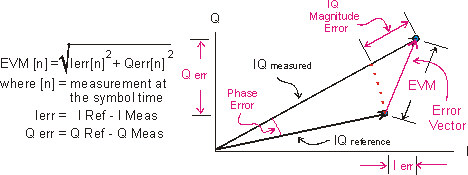Despread Error Vector Time (W-CDMA(3GPP)/HSPA)
When Demodulation is enabled, the trace data shows the Time Domain error vector trace data results for the specified Code Channel and code layer (Spread Code Length). trace data is the computed error vector between corresponding symbol points in the I/Q measured and I/Q reference signals. The data results can be viewed as Error Vector Magnitude, Error Vector Phase, only the I component or only the Q component (see Trace Data Formats below).

Increase the number of symbol points by increasing the (see Measurement Interval).
If normalization is off, the VSA shows the instantaneous magnitude for each point. If normalization is on, the VSA shows the error vector as a percentage. (See Normalize IQ Traces for an explanation of how this percentage is derived).
Trace Data Formats
It is important to remember that the trace is a time record made up of complex, time domain data. Each point in the time record has two components: I and Q. To make sense of the data, select an appropriate trace data format ( drop-down list).
-
: Shows the EVM Error vector magnitude (EVM): A quality metric in digital communication systems. See the EVM metric in the Error Summary Table topic in each demodulator for more information on how EVM is calculated for that modulation format. (Error Vector Magnitude).
-
: Shows the I component of the error vector.
-
Imag(Q) : Shows the Q component of the error vector.
-
Wrap Phase: Shows the Error Vector Phase error.
For example, to see the error vector magnitude, select the trace format (). Selecting computes the square root of the sum of the squares for each complex pair of points in the time record, which is the error vector magnitude (EVM):

How to Make a HSPA+MIMO Despread (x) Trace Data measurement
To learn how to use the Despread Traces parameter to make a Despread (x) Channel Trace Data measurement, see HSPA+ MIMO Overview - Despread (x) Trace Data.
See Also
About Trace Data (W-CDMA(3GPP))
